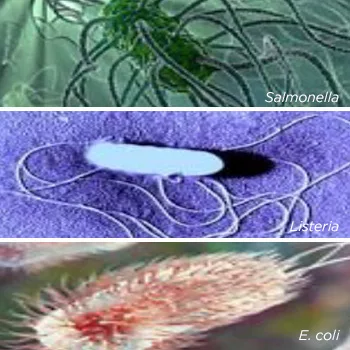Could ionAssure Be the Answer to Listeria, Salmonella and E. coli Contamination?

The Problem: Significant Hygienic Restoration Costs from Bioburden and Biofilm Contamination
Every facility is challenged with the control of contaminating, if not pathogenic, organisms that may result in costly recalls, production interruptions, product quarantines/disposals and their attendant revenue and market losses. Subsequently, significant investments are made in contamination control, facilities design, management and production training, regulatory compliance, sanitation, supply chain management and ever-more best operating-practices to minimize these occurrences.
The Solution: ionAssure™’s Rapid Effectiveness against a Broad Range of Contaminating Microbes
Rubber Fab Antimicrobial Technologies’ new ionAssure products integrate a patented and U.S. Environmental Protection Agency (EPA)-registered antimicrobial that is permanently embedded in our elastomers for durable, potent and long-lasting effectiveness against a broad spectrum of bacterial contamination challenges, including but not limited to Salmonella, Listeria and Escherichia coli.
Since the active antimicrobial can be incorporated into nearly any rubber, elastomer or polymer, it can be applied to an almost-endless list of products where contaminating bacteria and deteriorating-microbial growth is not wanted, including gaskets, seals, tubing and hose barbs.
The intent of this paper is to provide an in-depth, fact-based analysis of the critical attributes of a solution that has been integrated into its introductory range of gaskets and O-rings.
Product Characteristics
ionAssure possesses five critical attributes that make it a unique solution to prevent growth of microbes on their surfaces, maintain their sanitary condition and reduce sites for contaminant growth and propagation:
- Biofilm prevention and bioburden reduction
- Rapid effectiveness against a broad range of microbes including molds and fungi
- Proven durability, including strenuous wash, temperature and steam cycling applications
- Safety for both the manufacturers and end product users (customers)
- Sustainability friendly, in its composition and manufacturing process
The key to the longevity and effectiveness is the unique infusion of silver ions in a specialized carrier particle. The silver ions work together in a synergistic fashion, speeding cell wall penetration and maximizing effectiveness against the broadest range of microbes. As the ions bind to any microbes that may be present on the treated products, they disable their critical functions (metabolism, respiration, and reproduction).
 Process pipework and their related gaskets and seals can be exposed to contaminating microbes, and despite rigorous cleaning/sanitizing processes, may still provide “safe-harbor” sites that allow microbial growth and propagation to occur. If sufficient numbers of microbes are in close proximity over time, they can change from plank-tonic (essentially lone actors) to biofilm-producing communities through larger-scale bioattachment to surfaces and a process of cell-to-cell communication called “quorum sensing,” illustrated in Figure 1.
Process pipework and their related gaskets and seals can be exposed to contaminating microbes, and despite rigorous cleaning/sanitizing processes, may still provide “safe-harbor” sites that allow microbial growth and propagation to occur. If sufficient numbers of microbes are in close proximity over time, they can change from plank-tonic (essentially lone actors) to biofilm-producing communities through larger-scale bioattachment to surfaces and a process of cell-to-cell communication called “quorum sensing,” illustrated in Figure 1.
When quorum sensing occurs, the community of organisms starts producing a protective biofilm layer that allows the underlying microbes to proliferate to a point where large portions may slough off and contaminate downstream. Gasket and seal surfaces, although compressed between fitting faces, can offer ”safe-harbor” for microbes when capillary action allows migration along the inner seal/fitting face.
Looking for quick answers on food safety topics?
Try Ask FSM, our new smart AI search tool.
Ask FSM →
 Figure 2 illustrates how an ionAssure tri-clamp gasket will inhibit the growth of microbes along its entire treated surface and help prevent it from becoming a contaminant propagation site.
Figure 2 illustrates how an ionAssure tri-clamp gasket will inhibit the growth of microbes along its entire treated surface and help prevent it from becoming a contaminant propagation site.
Silver Ions: The Foundation of Speed and Effectiveness
 Silver is known for its broad-spectrum activity against multiple forms of microbes, including bacteria, mold, mildew and fungi. These ions synergistically act together to speed and enhance the power of microbial reduction. In Figure 3, we can see the silver ion action at work. Some ions begin the attack by aggressively breaking down the cell wall of the microbe, allowing other silver ions to attach internal mechanisms.
Silver is known for its broad-spectrum activity against multiple forms of microbes, including bacteria, mold, mildew and fungi. These ions synergistically act together to speed and enhance the power of microbial reduction. In Figure 3, we can see the silver ion action at work. Some ions begin the attack by aggressively breaking down the cell wall of the microbe, allowing other silver ions to attach internal mechanisms.
Once inside the cell, silver ions now launch a tri-modal attack against the microbe:
- Sterilization: Causing failure to replicate once silver has entered the cytoplasm and reacts with genomic DNA (reproduction)
- Suffocation: Causing failure of key enzymes associated with respiratory function (respiration)
- Starvation: Causing the failure of key enzymes associated with transmittance of nutrients across the cell wall (metabolism)
Zeolite Carrier Key to Controlled Ion Delivery
 Our antimicrbial solutions are based on a breakthrough in technology that releases natural silver ions from a zeolite carrier incorporated throughout the elastomer matrix. The zeolite carrier is an inorganic oxide where the active antimicrobial components (Ag+ ions) are infused in a three-dimensional carrier as illustrated in Figure 4. The multifaceted zeolite carrier provides an efficient three-dimensional release mechanism that delivers the ions independent of the particle’s orientation in the elastomer, polymer or rubber. Because the pores of the zeolite are interconnected, exposure of even a small corner of the particle allows access to all of the silver ions in that particle.
Our antimicrbial solutions are based on a breakthrough in technology that releases natural silver ions from a zeolite carrier incorporated throughout the elastomer matrix. The zeolite carrier is an inorganic oxide where the active antimicrobial components (Ag+ ions) are infused in a three-dimensional carrier as illustrated in Figure 4. The multifaceted zeolite carrier provides an efficient three-dimensional release mechanism that delivers the ions independent of the particle’s orientation in the elastomer, polymer or rubber. Because the pores of the zeolite are interconnected, exposure of even a small corner of the particle allows access to all of the silver ions in that particle.
The ion release is activated by moisture in the environment. Naturally occurring moisture on the surface of the product causes a finely controlled release of Ag+ ions to exchange with other positive ions (often sodium, or -thiol groups in the microbes), “on demand.”
The two conditions of “moisture” and “exchange with other positive ions” on the surface of a microbe must generally prevail before the particle “turns-on” and starts the exchange. Moisture in the air (ambient moisture) or direct contact with moisture (process fluid) activates the release of silver ions to the surface. When sodium or thiol groups present themselves in the vicinity of the particle, ion exchange ensues and the silver begins to attack. When these conditions do not prevail, then the particle’s ion-exchange mechanism turns-off and preserves the reservoir of ions for long term, durable action.
 As shown in Figure 5, the released ions are resident in a precisely filled, very sharp concentration gradient that are instantly available for anti-microbial action, but only resident at the immediate surface of the product.
As shown in Figure 5, the released ions are resident in a precisely filled, very sharp concentration gradient that are instantly available for anti-microbial action, but only resident at the immediate surface of the product.
Once a localized equilibrium of ions within a few monolayers of water has populated the effective gradient zone, the ions are reserved until needed for ion exchange. Beyond this “eradication zone,” the incidence of Ag+ ions is negligible. All the action is focused right where you want it—on the surface. This maximizes effectiveness without risking off-gassing, leaching or bioaccumulation that can be risks of chemical, synthetic organic or other solutions.
Testing Proves Rapid Effectiveness
.jpg) Required third-party antimicrobial performance testing produced dramatic results for representative organisms (E. coli, Salmonella and Listeria) within an industry standard (ASTM-2180) testing protocol. These tests, targeted for food, water, beverage, pharmaceutical and industrial marketplaces are summarized in the charts below. Performance exceeded the antimicrobial needs for typical commercial requirements, proving that ionAssure provides fast, high levels of efficacy.
Required third-party antimicrobial performance testing produced dramatic results for representative organisms (E. coli, Salmonella and Listeria) within an industry standard (ASTM-2180) testing protocol. These tests, targeted for food, water, beverage, pharmaceutical and industrial marketplaces are summarized in the charts below. Performance exceeded the antimicrobial needs for typical commercial requirements, proving that ionAssure provides fast, high levels of efficacy.
Durability stems from two main properties with our technology:
- Embedding the zeolite carriers throughout the entire matrix of the product
- Our unique, precisely controlled release of ions
Embedding Zeolite Carriers at and Below the Surface of Each Product
The zeolite carriers, prepopulated with silver ions, are blended with elastomers, rubber or polymer resins in a proprietary process to ensure consistent population of the carriers throughout the product.
By engineering and embedding the antimicrobial zeolite throughout treated products, we ensure maximum effectiveness for the use-life of the product and efficient use of the zeolite while ensuring critical characteristics of the underlying elastomer (durometer, compression, tenacity, elongation and temperature/steam cycling resistance), are maintained or enhanced.
 Figure 6 illustrates the visible protrusion of antimicrobial particles along the outside surfaces of each gasket. This is the area of the elastomer that contains the zeolite carriers. The “tuned” surface strain on the elastomer surface during the production process “migrates” a balanced proportion of the antimicrobial zeolite particles to the surface via compression and/or the “Poisson effect,” thereby priming the products for antimicrobial action as shown in Figure 7.
Figure 6 illustrates the visible protrusion of antimicrobial particles along the outside surfaces of each gasket. This is the area of the elastomer that contains the zeolite carriers. The “tuned” surface strain on the elastomer surface during the production process “migrates” a balanced proportion of the antimicrobial zeolite particles to the surface via compression and/or the “Poisson effect,” thereby priming the products for antimicrobial action as shown in Figure 7.
 You may recall from Figure 5 that the mobile field of ions maintain the antimicrobial effect between the zeolite particles (and the integrated elastomers in their immediate vicinity within the treated products).
You may recall from Figure 5 that the mobile field of ions maintain the antimicrobial effect between the zeolite particles (and the integrated elastomers in their immediate vicinity within the treated products).
This embedding of zeolite carriers both at and below the surface creates significant durability versus topical alternatives. Topical chemicals can easily degrade with ultraviolet (UV) exposure or be worn off with washings, abrasion, erosion or simple wear and tear. In contrast, each ionAssure product has continuous zeolite carriers throughout the products entire matrix. Wear and tear, abrasion, erosion or even UV degradation exposes more zeolite carriers by design, improving the products antimicrobial action by accessing the additional reservoirs of Ag+, and increasing long-term performance and durability.
Our Unique Controlled Release of Ions
As a point of emphasis, ionAssure’s durability also comes from our unique ability to release only the amount of ions that are required to maintain the antimicrobial effect. In contrast, other techniques may continually off-gas or leach into the environment regardless of need, depleting their efficacy both from use, cleaning cycles and time.
Safe for Your Customers, Employees and Partners
Silver, a naturally occurring element: Silver has been used since ancient times for water storage, compounds for the treatment of wounds, skin irritations, leg ulcers and disease. The 19th century brought the use of silver in Crede’s prophylaxis for infant eye drops, and the 20th and 21st centuries brought an expansion in medical uses from burn wards and environmental control products to “indwelling” catheters and stents, and face masks. Industrial and commercial applications have ranged from water filtration and treatment, food storage and handling equipment, to carpeting and active-wear.
No leaching or off-gassing: ionAssure technology does not “leach” or “gas-off” like other technologies that can migrate away or bioaccumulate on a macro-scale from the treated product. This also underscores our safety, even for dermal contact as the zeolite particles themselves are too large to migrate across and accumulate within cell walls. Therefore, we have the inability to bioaccumulate within cells nor within the broader environment.
 Figure 8 depicts “zone-of-inhibition” efficacy testing. As you can see, chemically applied or topical solutions leach away from the treated article and therefore establish a zone of inhibition around the test article. This means that the antimicrobial chemical escapes on a macro-scale and may accumulate in the environment (e.g., contaminate or impart flavor to product). In contrast, ionAssure-impregnated elastomers on the right has no zone related to leaching.
Figure 8 depicts “zone-of-inhibition” efficacy testing. As you can see, chemically applied or topical solutions leach away from the treated article and therefore establish a zone of inhibition around the test article. This means that the antimicrobial chemical escapes on a macro-scale and may accumulate in the environment (e.g., contaminate or impart flavor to product). In contrast, ionAssure-impregnated elastomers on the right has no zone related to leaching.
Regulatory passages: The zeolite employed in the ionAssure system has passed tough regulatory requirements starting with an EPA registration, requiring a six-pack of acute studies and mutagenicity study.
All of these tests have led to the following summary of regulatory passages for the particle:
- EPA-registered bacteriostatic agent for broad range of uses, for treated articles under 40 CFR 152.25(a)
- EU Biocidal Products Directive 98/88/EC, BPR 95, European Food Safety Agency, U.S. Food and Drug Administration Food Contact
- NSF 51 Food/Water Materials
These support additional product specific third-party qualifications such as 3A for Buna/nitrile products in the food & beverage industries, and USP Class VI for silicone products in the biopharmaceutical industries.
 A summary of safety passages and certificates is provided below for reference in Figure 9.
A summary of safety passages and certificates is provided below for reference in Figure 9.
The sustainability friendly basis: ionAssure’s non-leaching, no gas-off antimicrobial technology does not bioaccumulate in the environment, and is non-transdermal by making use of ppb releases of naturally effective and highly reactive silver-ions.
Summary
Simply put, ionAssure has amassed a superior portfolio of antimicrobial performances supported by regulatory and safety qualifications, making us the complete solution suitable for your process gasket, 0-ring and future hose and tubing applications.
Bill Hurst is president of Rubber Fab Antimicrobial Technologies. Contact him at 617-515-2585 or bhurst@rubberfab.com.








